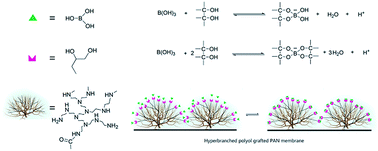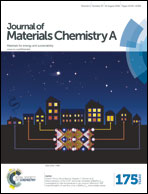Hyperbranched grafting enabling simultaneous enhancement of the boric acid uptake and the adsorption rate of a complexing membrane
Abstract
Efficient polymeric adsorbents, including complexing membranes, attract increasing attention due to the global occurrence of micropollutants in water resources. Grafting polyhydroxy polymers onto a microporous membrane surface to prepare a complexing membrane for flow-through boron removal is also an emerging method. However, it remains a great challenge to develop efficient sorbents with both high capacity and high adsorption rate. In this work, hyperbranched polyols are grafted onto a polyacrylonitrile (PAN) membrane surface to prepare complexing membranes with high capacity and high adsorption rate, which utilize the structural characteristics of hyperbranched molecules to optimize the three-dimensional distribution of the chelating ligands. First, the PAN membrane was grafted with three hyperbranched polyethyleneimine (HPEI) macromolecules through a water mediated hydrolysis and amidation reaction in an autoclave followed by a ring opening reaction with glycidol. ATR-FTIR, XPS, FESEM and WCA methods were used to characterize the modified membranes. The results demonstrated that HPEI was successfully anchored onto the membrane surface and reacted with glycidol. Large quantities of hydroxyl groups were enriched on the surface of the membranes leading to rougher and superhydrophilic surfaces. The study on boron adsorption shows that the complexing membrane can absorb 3.2 mmol g−1 within only 4 min, which is superior to other reported sorbents. The adsorption isotherm can be described by the Langmuir model and the kinetic adsorption data fit very well with the pseudo-first-order expression. In addition, the boron adsorption can be completely regenerated for ten cycles of use by 15 min acid leaching without obvious degradation. The rapid boron removal and high regeneration are believed to benefit from the hyperbranched scaffold thanks to the high density and good accessibility of the ligands.


 Please wait while we load your content...
Please wait while we load your content...